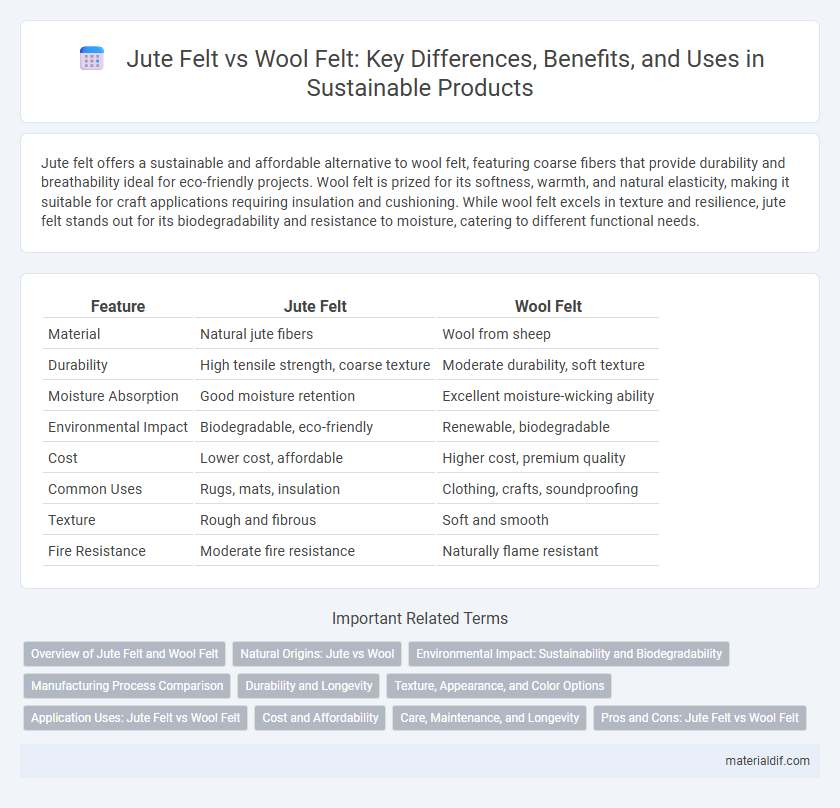Jute felt offers a sustainable and affordable alternative to wool felt, featuring coarse fibers that provide durability and breathability ideal for eco-friendly projects. Wool felt is prized for its softness, warmth, and natural elasticity, making it suitable for craft applications requiring insulation and cushioning. While wool felt excels in texture and resilience, jute felt stands out for its biodegradability and resistance to moisture, catering to different functional needs.
Table of Comparison
| Feature | Jute Felt | Wool Felt |
|---|---|---|
| Material | Natural jute fibers | Wool from sheep |
| Durability | High tensile strength, coarse texture | Moderate durability, soft texture |
| Moisture Absorption | Good moisture retention | Excellent moisture-wicking ability |
| Environmental Impact | Biodegradable, eco-friendly | Renewable, biodegradable |
| Cost | Lower cost, affordable | Higher cost, premium quality |
| Common Uses | Rugs, mats, insulation | Clothing, crafts, soundproofing |
| Texture | Rough and fibrous | Soft and smooth |
| Fire Resistance | Moderate fire resistance | Naturally flame resistant |
Overview of Jute Felt and Wool Felt
Jute felt is a sustainable, biodegradable material made from natural jute fibers known for its coarse texture and durability, commonly used in eco-friendly upholstery, insulation, and crafts. Wool felt, derived from animal wool, offers superior softness, elasticity, and thermal insulation, making it ideal for clothing, padding, and artistic applications. Both materials provide versatile options, with jute felt emphasizing eco-conscious construction and wool felt focusing on comfort and resilience.
Natural Origins: Jute vs Wool
Jute felt is derived from the long fibers of the jute plant, known for its rapid growth and eco-friendly cultivation, making it a sustainable alternative to animal-based materials. Wool felt originates from the fleece of sheep, offering natural insulation properties but involving animal farming and shearing processes. Both materials emphasize natural origins, with jute felt providing a plant-based option and wool felt delivering traditional animal-based warmth and durability.
Environmental Impact: Sustainability and Biodegradability
Jute felt offers a more sustainable alternative to wool felt due to its rapid renewability and lower environmental footprint, as jute cultivation requires less water and pesticides compared to sheep farming. Both jute and wool felts are biodegradable, but jute decomposes faster, reducing long-term waste accumulation. Choosing jute felt supports eco-friendly production practices with minimized greenhouse gas emissions and soil degradation.
Manufacturing Process Comparison
Jute felt is manufactured by compressing natural jute fibers combined with synthetic binders, resulting in a durable, eco-friendly material with a coarse texture. Wool felt is produced by matting, condensing, and pressing wool fibers together through heat, moisture, and agitation without synthetic additives, creating a dense and soft fabric. The key manufacturing difference lies in jute felt's use of chemical binders for strength, whereas wool felt relies on natural fiber entanglement.
Durability and Longevity
Jute felt exhibits superior durability compared to wool felt due to its natural resistance to wear and moisture, making it ideal for heavy-duty applications. Wool felt, while softer and more flexible, tends to compress and degrade faster under consistent pressure and humidity. The longevity of jute felt surpasses wool felt in environments requiring robust and long-lasting material performance.
Texture, Appearance, and Color Options
Jute felt features a coarse texture with a natural, rustic appearance due to its plant-based fibers, offering earthy brown and beige color options that emphasize its organic origin. Wool felt provides a softer, smoother texture with a more refined and plush appearance, available in a broader spectrum of vibrant colors due to its dye-friendly protein fibers. The choice between jute and wool felt depends on desired tactile feel, visual aesthetics, and color versatility for specific craft or industrial applications.
Application Uses: Jute Felt vs Wool Felt
Jute felt is widely used in eco-friendly packaging, agriculture, and upholstery due to its natural biodegradability and moisture resistance, making it ideal for sustainable product designs. Wool felt excels in insulation, soundproofing, and high-end crafts because of its superior thermal properties and durability. Both materials serve distinct purposes where jute felt emphasizes eco-conscious applications, while wool felt provides enhanced performance in insulation and decorative uses.
Cost and Affordability
Jute felt is significantly more affordable than wool felt, making it a cost-effective option for budget-conscious projects. The raw material cost of jute is lower due to its widespread availability and rapid growth cycle compared to the labor-intensive production of wool felt. This price difference makes jute felt ideal for large-scale applications where cost efficiency is crucial.
Care, Maintenance, and Longevity
Jute felt requires gentle handling and occasional spot cleaning to maintain its natural fibers, as it is prone to moisture damage and mildew if exposed to excessive water. Wool felt is more resilient, allowing for mild detergent washing and better resistance to wear and tear, extending its lifespan with regular maintenance. Proper storage in a dry environment significantly enhances the longevity of both jute and wool felt products.
Pros and Cons: Jute Felt vs Wool Felt
Jute felt is highly durable, eco-friendly, and cost-effective, making it ideal for sustainable projects, but it tends to be rougher and less insulating compared to wool felt. Wool felt offers superior softness, excellent thermal insulation, and natural moisture-wicking properties, yet it comes with a higher price and requires more careful maintenance. Choosing between jute felt and wool felt depends on balancing affordability and eco-friendliness against comfort and performance needs.
Jute Felt vs Wool Felt Infographic

 materialdif.com
materialdif.com